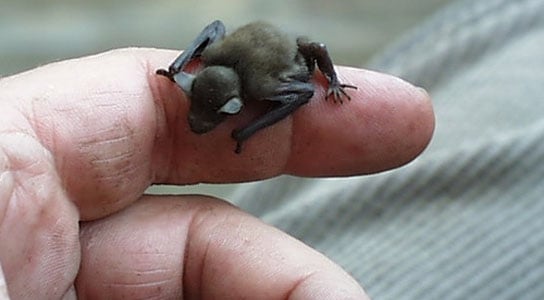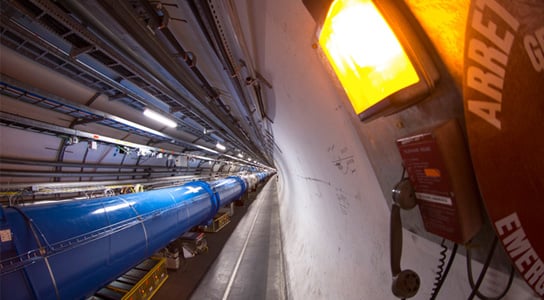SciTechDaily: “Grand Canyon Thought to Be 65 Million Years Older Than Previous Estimates” plus 5 more |  |
- Grand Canyon Thought to Be 65 Million Years Older Than Previous Estimates
- Kitti’s Hog-Nosed Bat Is World’s Smallest Mammal
- Hubble Views Galaxy ESO 318-13
- As Supersymmetry Fails, Physicists Looking for New Models
- Lines on Crocodiles’ Crania Are Cracks in Skin, Not Scales
- New Finding Challenges Theories of How Rocky, Earth-Scale Planets Form
| Grand Canyon Thought to Be 65 Million Years Older Than Previous Estimates Posted: 03 Dec 2012 09:17 AM PST A new analysis of the mineral grains from the bottom of the Grand Canyon indicates that it was formed about 70 million years ago, during the late Cretaceous Period, a time when dinosaurs roamed the Earth. The scientists published their findings in the journal Science. This new research pushes back the date for the formation [...] The post Grand Canyon Thought to Be 65 Million Years Older Than Previous Estimates appeared first on SciTech Daily. |
| Kitti’s Hog-Nosed Bat Is World’s Smallest Mammal Posted: 03 Dec 2012 08:59 AM PST The Kitti’s hog-nosed bat (Craseonycteris thonglongyai), sometimes referred to as the bumblebee bat due to its diminutive size, was discovered in 1970s and could arguably be the world’s smallest mammal, depending on how size is defined. C. thonglongyai is listed as vulnerable by the IUCN and is found in western Thailand and southeast Burma, in [...] The post Kitti’s Hog-Nosed Bat Is World’s Smallest Mammal appeared first on SciTech Daily. |
| Hubble Views Galaxy ESO 318-13 Posted: 03 Dec 2012 08:38 AM PST This is new image from the Hubble Space Telescope shows galaxy ESO 318-13 and other more distant galaxies, which are located millions of light-years from Earth. The brilliant cascade of stars through the middle of this image is the galaxy ESO 318-13 as seen by the NASA/ESA Hubble Space Telescope. Despite being located millions of [...] The post Hubble Views Galaxy ESO 318-13 appeared first on SciTech Daily. |
| As Supersymmetry Fails, Physicists Looking for New Models Posted: 03 Dec 2012 08:16 AM PST As the Large Hadron Collider has been unable to find any of the particles suggested by supersymmetry, theoretical particle physicists are trying to change their worldview, away from supersymmetry to theories that could explain the results. So far, there have been no hints beyond the Standard Model of Particle Physics from the LHC. A recent [...] The post As Supersymmetry Fails, Physicists Looking for New Models appeared first on SciTech Daily. |
| Lines on Crocodiles’ Crania Are Cracks in Skin, Not Scales Posted: 03 Dec 2012 07:54 AM PST The "scales" on a crocodile's cranium aren't really scales, but simple physical cracks rather than developmentally programmed scales that cover the rest of a crocodile's body. Researchers had previously assumed that the deep lines marked boundaries between scales. The scientists published their findings in the journal Science. Understanding the physical process by which the cracks [...] The post Lines on Crocodiles’ Crania Are Cracks in Skin, Not Scales appeared first on SciTech Daily. |
| New Finding Challenges Theories of How Rocky, Earth-Scale Planets Form Posted: 03 Dec 2012 07:21 AM PST While viewing the young brown dwarf ISO-Oph 102, an international team of astronomers pinpointed carbon monoxide gas around the brown dwarf and found that the outer region of the dusty disc encircling the brown dwarf contains millimeter-sized solid grains. Astronomers using the Atacama Large Millimeter/submillimeter Array (ALMA) have for the first time found that the [...] The post New Finding Challenges Theories of How Rocky, Earth-Scale Planets Form appeared first on SciTech Daily. |
| You are subscribed to email updates from SciTech Daily To stop receiving these emails, you may unsubscribe now. | Email delivery powered by Google |
| Google Inc., 20 West Kinzie, Chicago IL USA 60610 | |







No comments:
Post a Comment
Comment as Anonymous - no need your name...